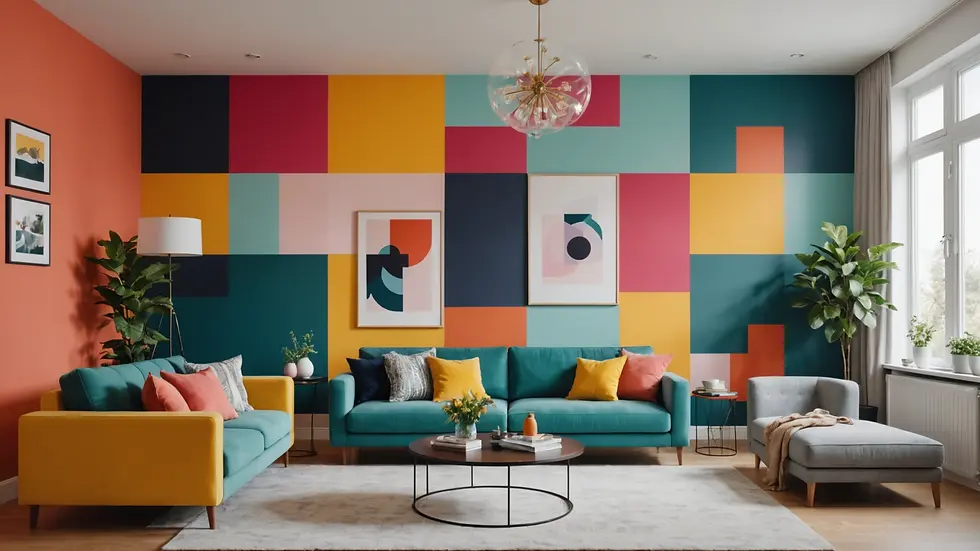Unlock the Ultimate Color Blocking Secrets for Home Renovation Magic! Are You Ready to Transform Your Home? 🎨✨
- William Black
- Dec 16, 2024
- 4 min read
Color blocking is more than just a fashion trend; it’s a powerful design technique that can dramatically enhance your home's beauty and value. Picture stepping into a home where walls splashed with vibrant colors immediately capture your attention. Whether you plan to revamp a single room or your entire house, mastering color blocking can help you create breathtaking environments.
In this guide, we’ll uncover exciting color blocking secrets, provide practical tips for implementation, and inspire you with innovative ideas to make your home shine. Get your paintbrush ready; let’s dive in!
What is Color Blocking?
Color blocking involves using bold, contrasting colors in large, defined areas. This design choice naturally draws the eye and creates striking focal points. For example, imagine a living room with one wall painted a warm orange while others are a soft beige, creating a cozy yet dynamic atmosphere.
Understanding color theory is vital when applying color blocking. Colors evoke different emotions. For instance, warm tones like reds and yellows are stimulating, whereas cooler shades like blue and green evoke tranquility. While trusting your instincts is important, a basic understanding of color can lead to beautiful outcomes.
Why Use Color Blocking in Home Renovation?
1. Boost Aesthetics
Color blocking greatly improves the aesthetic appeal of your home. A thoughtfully executed color scheme not only attracts attention but also harmonizes with architectural features. For instance, bright blue accents can highlight a white kitchen's cabinetry, creating a stunning visual effect.
2. Increase Property Value
Unique design choices, including bold color blocking, can elevate your property’s marketability. Homes that stand out in the neighborhood often maintain higher values. For example, a study by Zillow indicated that homes with distinctive color schemes sold 20% faster than those painted in neutral tones.
3. Personal Expression
Your home should represent your personality. Color blocking gives you the freedom to express this through unique palettes and configurations. Whether you prefer vibrant tropical colors or soft pastels, this technique allows you to create a space that feels wholly yours.
Choosing the Right Colors
Understanding Color Wheel Basics
Becoming familiar with the color wheel is crucial for effective color blocking. This tool helps identify complementary colors (those opposite each other) and analogous colors (those next to each other). For example, a pairing of purple and yellow can create a lively contrast, while pink and orange offer a cheerful and inviting combination.
Cool vs. Warm Tones
Warm colors, like reds and oranges, create an energetic environment, while cool colors, like blues and greens, foster relaxation. Consider the desired mood in each room. For a vibrant atmosphere in a playroom, you might choose bright yellows and greens, while a bedroom may benefit from cool blues and grays to promote calmness.
Practical Tips for Color Blocking
1. Start Small
If you're new to color blocking, begin with small areas such as an accent wall or decorative objects. For example, you might start with bright orange throw pillows on a neutral sofa. This allows for experimentation and can make a big impact without overwhelming the space.

2. Use Painter’s Tape
Precision is vital for effective color blocking. Painter’s tape helps achieve clean lines, ensuring that your color blocks are sharp and intentional. You can create interesting geometric shapes, like triangles or rectangles, for a modern and playful feel.
Color Blocking Ideas by Room
1. Living Room
As the heart of the home, the living room deserves a thoughtful color scheme. Consider creating an accent wall with a bold color, like a rich teal, and balance it with softer tones throughout the room. Alternatively, mix and match colorful furniture—imagine a vibrant red sofa paired with a blue armchair for a delightful contrast.

2. Kitchen
Transform your kitchen with color-blocked cabinets! A combination of crisp white and deep navy can create a clean and modern look. Adding a bold color to your backsplash can also add personality—think a burnt orange tile against white cabinets for an eye-catching effect.
3. Bathroom
A calming bathroom is crucial for relaxation. Combine soft, neutral tones like beige with a pop of color, such as a light turquoise. This combination creates a tranquil retreat while offering a refreshing vibe.
Implementing Color Blocking in Open Spaces
In open-concept homes, color blocking can be a bit more complex but equally exciting!
Use Color Zones
To define different areas, create distinct color zones. For instance, you might choose warm shades in the living room while using cooler tones in the dining area. This separation maintains the flow of the space while providing visual interest.
Consider Flow
Select colors that transition smoothly between areas. This approach promotes a cohesive look while allowing each section to showcase its unique characteristics. Using similar shades throughout can help achieve this while still introducing slight variations.
The Finishing Touches
Once the paint is dry, think about accessories to complement your color blocking. Decorate with artwork that includes colors from your scheme to unify the room. Additionally, colorful throw pillows and area rugs can enhance the theme without overshadowing it.
Don’t forget to leverage natural light! Observe how colors appear differently throughout the day. This awareness can help you select the perfect shades.
Revamp Your Home with Color Blocking
Color blocking serves as an empowering design tool capable of revitalizing your home while potentially increasing its value. It's more than simply placing two colors together; it's about understanding the dynamics of colors and the feelings they can evoke. With the right approach, you can create stunning environments that reflect your style.
Are you excited to pick up your paintbrush and explore the world of color blocking? Let your creativity flow as you transform your home into a vibrant reflection of yourself!
Dive into this decorating adventure and let your personality shine. Happy decorating!





Comments